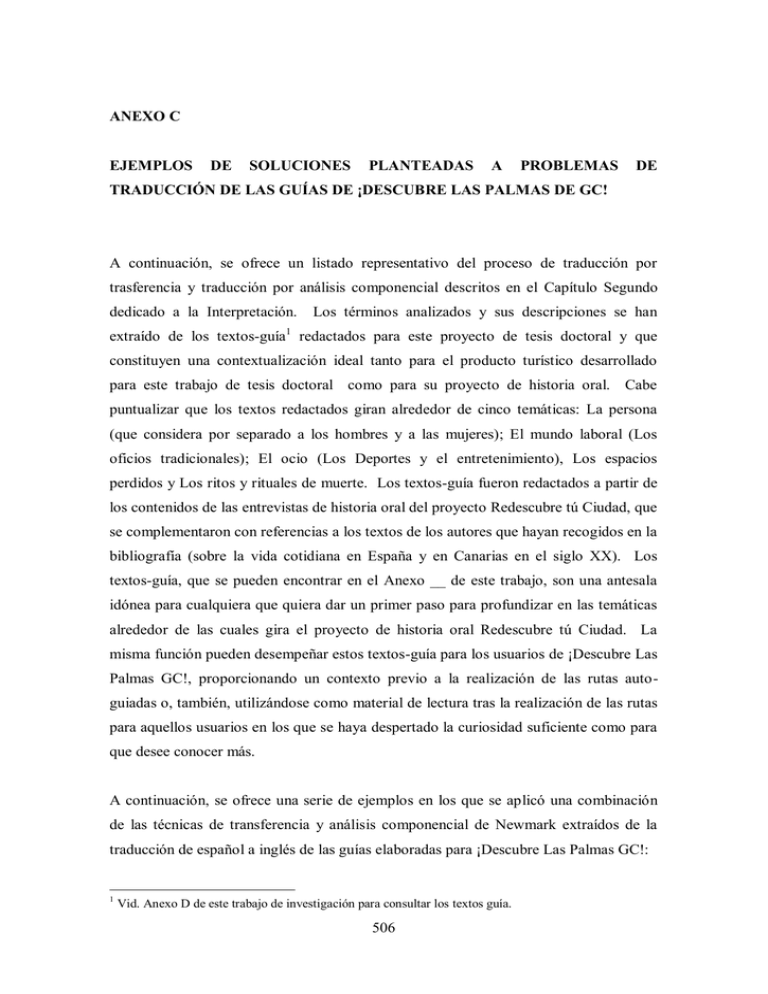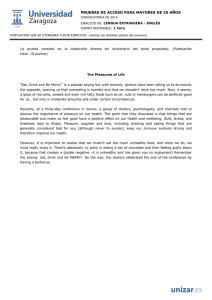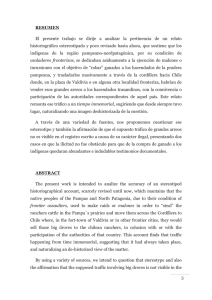Anexo_C.pdf
Anuncio

ANEXO C EJEMPLOS DE SOLUCIONES PLANTEADAS A PROBLEMAS DE TRADUCCIÓN DE LAS GUÍAS DE ¡DESCUBRE LAS PALMAS DE GC! A continuación, se ofrece un listado representativo del proceso de traducción por trasferencia y traducción por análisis componencial descritos en el Capítulo Segundo dedicado a la Interpretación. Los términos analizados y sus descripciones se han extraído de los textos-guía1 redactados para este proyecto de tesis doctoral y que constituyen una contextualización ideal tanto para el producto turístico desarrollado para este trabajo de tesis doctoral como para su proyecto de historia oral. Cabe puntualizar que los textos redactados giran alrededor de cinco temáticas: La persona (que considera por separado a los hombres y a las mujeres); El mundo laboral (Los oficios tradicionales); El ocio (Los Deportes y el entretenimiento), Los espacios perdidos y Los ritos y rituales de muerte. Los textos-guía fueron redactados a partir de los contenidos de las entrevistas de historia oral del proyecto Redescubre tú Ciudad, que se complementaron con referencias a los textos de los autores que hayan recogidos en la bibliografía (sobre la vida cotidiana en España y en Canarias en el siglo XX). Los textos-guía, que se pueden encontrar en el Anexo __ de este trabajo, son una antesala idónea para cualquiera que quiera dar un primer paso para profundizar en las temáticas alrededor de las cuales gira el proyecto de historia oral Redescubre tú Ciudad. La misma función pueden desempeñar estos textos-guía para los usuarios de ¡Descubre Las Palmas GC!, proporcionando un contexto previo a la realización de las rutas autoguiadas o, también, utilizándose como material de lectura tras la realización de las rutas para aquellos usuarios en los que se haya despertado la curiosidad suficiente como para que desee conocer más. A continuación, se ofrece una serie de ejemplos en los que se aplicó una combinación de las técnicas de transferencia y análisis componencial de Newmark extraídos de la traducción de español a inglés de las guías elaboradas para ¡Descubre Las Palmas GC!: 1 Vid. Anexo D de este trabajo de investigación para consultar los textos guía. 506 - (…) The cambulloneros were men who sailed against the wind in small boats out to the foreign ships - mainly British- that were anchored close to the port. Their name comes from the phonetic adaptation of: ‘Can buy on?’ (cam-bu-llón), the expression that these sailors used to greet those on board (…) - (…) Stairways and narrow alleys go up the ‘riscos’, Spanish for ‘cliffs’, (…) - (…) and the ‘ribera’ carpenter’s workshops, literally, the carpenter’s workshops on the river or sea bank, - (…) by the typical ‘casas terreras’, the type of construction that was most common up until the Sixties with only one height, normally aligned like semidetached houses with one door and two windows placed arbitrarily on the façade. (…) - (…) along the wall of the barranco Guiniguada (the ‘gulley’ that divided the neighbourhoods of Vegueta and Triana) - (…) and institutions such as Cáritas (the official national confederation of the charitable), (…) - (…) don Selim would give the bus drivers of the coches de hora (literally the ‘hour buses’ because they departed on the hour) a cigar from time to time. (…) - (…) the terms Jarabandino or Jarandino, used in the Canary Islands to name those men of Arab origin who migrated to the islands, especially those who came from the rural territories of Lebanon, Syria and Palestine. (…) - (…) selling figurines for the typical Christmas belén, the nativity scenes that are put together in family homes, businesses, institutions and public spaces during Christmas time. (…) - (…) in the Vega family’s workshop, maestro (Spanish for master) Daniel Vega Armas, the founder, (…) - (…) specialized in making boots for the motorizados, name given to the motorized police, of all the districts in the island. (…) - (…) From Easter we must mention the anisette flavoured bollos de alma, literally ‘soul buns’; also the huesos de santo, that is ‘saint’s bones’ a white and long marzipan pastry (almond paste) with a sweet yolk filling similar to a bone with its marrow, and of course the buñuelos de viento, a kind of fritterball that in Parrilla is filled only with pastry cream, following the tradition 507 (you can also find them nowadays filled with chocolate cream or whipped cream). (…) - (…) to eat the traditional tortillas de Carnaval, a type of pancake made during this festivity (…) - (…) recommend the milhojas (the ‘thousand layers’ pastry) a type of puff pastry with meringue (…) - (…) and hired a mancebo (word that was used back then for ‘assistant’) named Salvador (…) - (…) When the chemist prepared his own formulas the shop received in Spain the name of botica, and the back room was called the rebotica, words that have fallen out of use in favour of farmacia (…) - (…) boticas, just like barber shops, were the place where animated tertulias or get-togethers took place (…) 508



